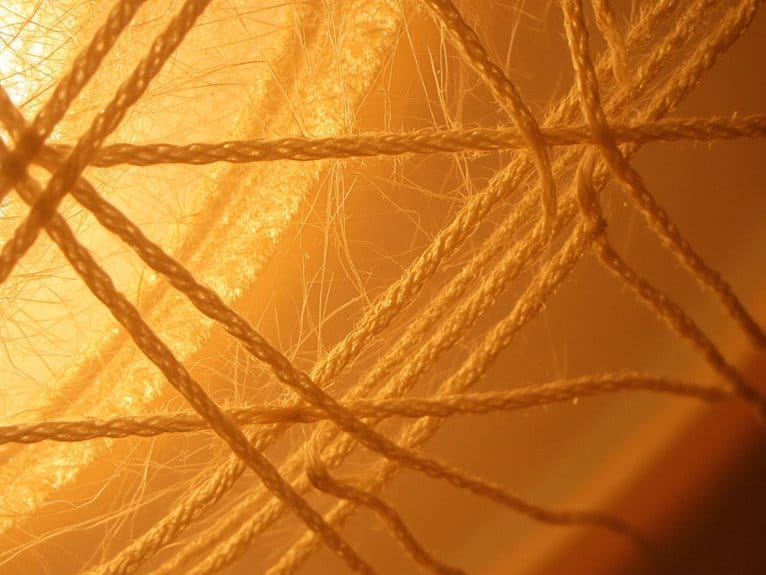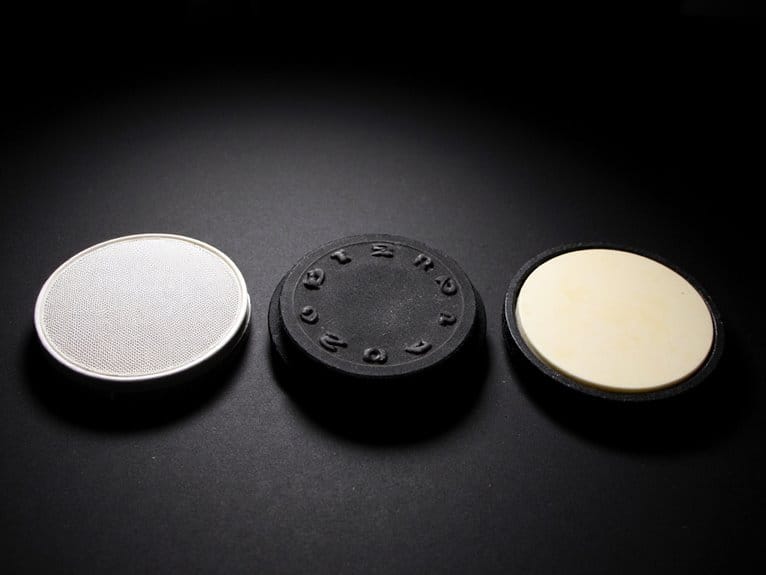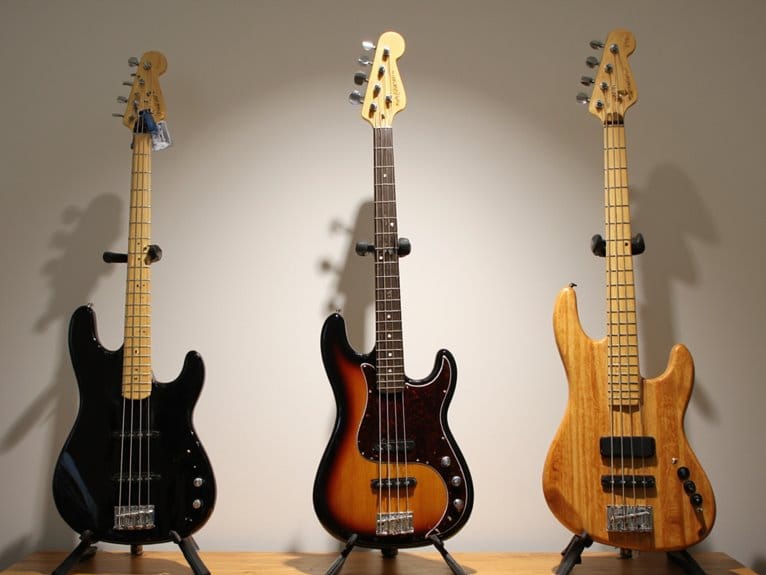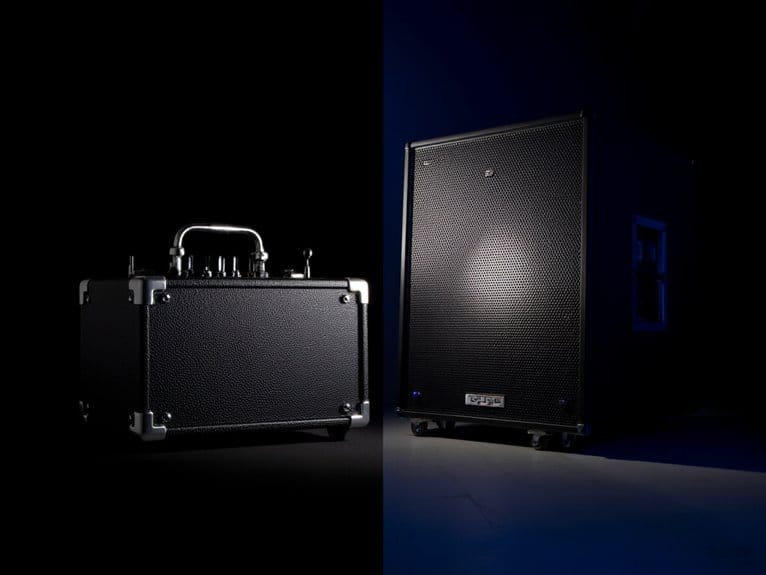Drum Set Heads Under the Microscope: Materials and Construction
When you examine drumheads closely, you’ll discover they’re engineered from either natural animal hides or synthetic Mylar-based polymers, with single-ply construction offering brighter tones and extended sustain while double-ply designs provide warmer sounds and enhanced durability for aggressive playing styles. Modern heads feature specialized coatings that reduce overtones, textured surfaces for brush work, and internal damping rings that control sustain without external mutes. Understanding these microscopic details reveals how manufacturers optimize each component for specific musical applications.
We are supported by our audience. When you purchase through links on our site, we may earn an affiliate commission, at no extra cost for you. Learn more.
Notable Insights
- Natural hides offer warmer, complex tones but are weather-sensitive, while synthetic Mylar provides crisp articulation and durability.
- Single-ply heads (7-12 mil) produce brighter tones with extended sustain; double-ply creates warmer sound and improved durability.
- Coatings reduce overtones for better articulation, while textured surfaces enhance brush performance and internal damping manages sustain.
- Material thickness, playing style, humidity control, and regular maintenance significantly impact drumhead longevity under professional use.
- Different genres require specific head types: jazz needs single-ply sensitivity, rock/metal benefits from double-ply durability and sustain control.
Synthetic Films vs. Natural Skins: Core Material Choices
When you’re selecting drumheads, the fundamental choice between synthetic films and natural skins will dramatically shape your instrument’s voice, durability, and maintenance requirements.
Your drumhead selection between synthetic films and natural skins fundamentally determines your instrument’s sonic character, longevity, and upkeep demands.
Natural vs synthetic materials offer distinctly different sonic personalities, with animal hides like goat and cow delivering warmer, more complex tones that fluctuate beautifully with environmental conditions.
Synthetic films, primarily Mylar-based polymers, provide crisp articulation and weather-resistant consistency that touring musicians absolutely depend on. Modern synthetic drumheads feature advanced construction techniques like dual-ply design that combine different mil thicknesses to achieve specific tonal characteristics and enhanced durability.
While natural skins excel in traditional contexts with their organic resonance and subtle dynamic expression, synthetic heads offer superior tonal versatility through engineered formulations like REMO’s Renaissance or Ebony Suede lines.
Your choice ultimately depends on whether you prioritize the unpredictable character of natural materials or the reliable performance of modern synthetics. For drummers seeking ethical alternatives, synthetic heads eliminate concerns about animal product usage while maintaining professional sound quality.
Natural hides absorb moisture from the surrounding air, causing the drum head pitch to drop in humid conditions and rise when the environment becomes dry.
Single-Ply and Double-Ply Construction Differences
Beyond the fundamental material choice lies another critical decision that’ll shape your drum’s character: whether you opt for single-ply or double-ply construction.
Single-ply heads, typically ranging from 7 to 12 mil thickness, vibrate more freely and produce brighter tones with extended sustain and pronounced overtones. Double-ply heads combine two layers, often 7 mil sheets or mixed configurations like 7.5/3 mil, creating warmer, more controlled sound profiles with enhanced durability.
While single-ply construction suits lighter playing styles requiring dynamic sensitivity, double-ply heads excel in aggressive genres demanding articulation and punch. The increased durability of double-ply construction makes them particularly suitable for drummers with aggressive playing techniques. Single-ply heads deliver a lighter stick feel with more give under the stick, providing enhanced responsiveness for nuanced playing.
Your tuning techniques will vary accordingly, as single-ply heads respond better to brightness adjustments, whereas double-ply heads allow focused low-end enhancement and tighter control.
Coatings and Dampening Technologies
While ply construction determines your drumhead’s fundamental behavior, the coating and dampening technologies applied to that membrane will fine-tune its sonic character in ways that can make or break your sound.
You’ll find that coating impact extends far beyond simple aesthetics, with textured Mylar layers dampening overtones while enhancing brush articulation for jazz applications. Modern UV-cured coatings resist wear and maintain sonic consistency longer than traditional treatments.
The dampening effects you’ll experience include:
- Natural mass dampening from coating layers that control resonance and tighten response
- Internal damping rings printed beneath coatings to reduce sustain without external mutes
- Textured surfaces that provide genre-specific dampening for jazz and gospel styles
- Proprietary treatments that resist denting while preserving surface integrity and consistent stick response
Advanced UV technology features patented UV-cured formulations that prevent flaking and chipping while delivering exceptional longevity under demanding playing conditions. Coated heads deliver enhanced sensitivity that proves particularly beneficial for drummers seeking greater responsiveness in their playing dynamics.
Durability Factors for Professional Performance
| Factor | Impact on Durability | Professional Consideration |
|---|---|---|
| Material Thickness | Single-ply: responsive but fragile | Choose based on venue demands |
| Playing Style | Heavy hitting accelerates wear | Develop dynamic control techniques |
| Environmental Conditions | Humidity causes stretching/warping | Use climate-controlled storage |
| Maintenance Frequency | Regular tuning prevents weak spots | Schedule weekly tension checks |
Smart maintenance tips include rotating hit positions and avoiding excessive tension, while monitoring environmental impacts like temperature fluctuations that compromise structural integrity over extended touring periods. Quality materials significantly influence longevity, with premium drum heads featuring superior construction that withstands professional demands. Professional drummers should prioritize regular assessment of their drum heads to identify subtle changes in sound quality before performance issues arise.
Specialized Heads for Different Drum Types
When you’re selecting drumheads for different types of drums, the material composition and construction methods I’ve discussed earlier become even more critical, since each drum serves a unique acoustic purpose within your kit.
Your batter head options vary dramatically depending on whether you’re outfitting toms, snares, or kick drums, with each requiring specific thickness, coating, and ply configurations to achieve peak performance.
Different genre specifications demand targeted approaches:
- Rock/Metal: Double-ply coated heads with reinforced dots provide durability under aggressive playing while maintaining controlled sustain and projection.
- Jazz: Single-ply coated heads offer sensitivity for brush techniques and articulate ghost notes.
- Pop/Country: Clear medium-thickness heads deliver brightness and note definition.
- Funk/R&B: Medium coated batter heads create warm, punchy tones with reduced overtones.
Your resonant heads work below the batter surface to enhance the overall tone richness and acoustic response of each drum. Remember that even tension across all tuning lugs directly influences your drumhead’s sound quality, sustain characteristics, and overall tonal response regardless of the specific material construction you choose.
On a final note
You’ve now got the technical foundation to make informed drumhead choices, whether you’re eyeing single-ply Mylar for crisp attack, double-ply constructions for enhanced durability, or specialized coated options that’ll dampen unwanted overtones. I’ll admit the material science gets dense, but understanding these construction differences-from film thickness to dampening ring placement-directly impacts your kit’s performance, longevity, and that signature sound you’re chasing in your playing style.






